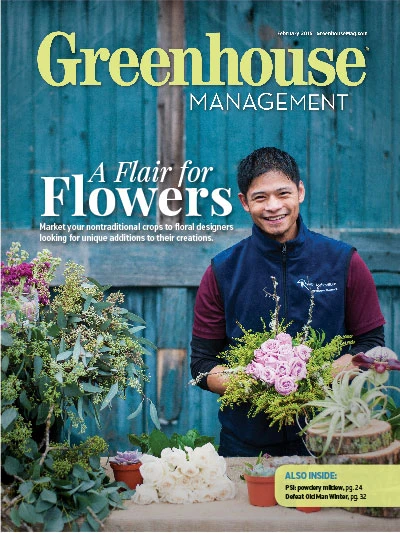 School is often where we find ourselves and our purpose.
School is often where we find ourselves and our purpose.
Courtney Crawford, the 25-year old head grower at Millcreek Plants, says she started to discover her purpose in a high school classroom. Her coursework covered a broad range of horticulture topics including greenhouses, landscape and floral design. That appetizer to the industry led her to Ohio State University’s Agricultural Technical Institute, where she studied a wide variety of plants.
“Looking back, this is where I feel I truly began diving into my passion for the horticultural industry, and it’s only continued to grow from there,” she says.
Having honed her passion, Crawford quickly found herself the head grower at Millcreek, an Ohio-based grower that specializes in herbaceous perennials, herbs, groundcovers, ferns, ornamental grasses, vines and annuals grown in containers. On an average day, she oversees five growing spaces, handles daily walk-through, scouting, watering and monitoring overall plant health.
“The day also includes seeding, sticking cuttings and ordering the essential items for proper production. Planning concerns such as environmental needs, shipping weeks and even the amount of time the material that will be in my facility are all factors that go into my production plan. Other factors that can influence my plan are whether or not we can internally produce or if we buy in URC’s. Currently we produce, around 700,000 plants each year from our propagation facility,” she says.
And Crawford has a deep passion for her job.
“At this point in my life, I feel like propagation has been my favorite area to work thus far. It’s probably the area I’ve had to learn the most, but it’s only given me a better appreciation for the full circle of plant life,” she says.
Limiting the chemicals
Chemicals are a sticking point (no pun intended) for Crawford. She’d like to see the protocol changed for chemical applications.
“I would like to see more focus on how we can get the control on pest problems without involving growers in the application processes,” she says.
 She believes that change will take one of two forms.
She believes that change will take one of two forms.
First, the use of environmental and biological processes will increase, allowing for better control of disease and pest susceptibility.
“My hope is that the continued studying of the biological processes will allow us to make this a forefront in the line of defense for pest management. By doing this, I hope to see chemicals become a secondary option for larger outbreaks,” she says.
The second option would be the increased use of automation. “If we could have better control without needing to be physically exposed, that would be the best case scenario. While this could be a great solution, I worry about losing the personal touch that produces a quality standard to the crop.”
Cha, cha, changing…
Despite her young age, Crawford is already an industry veteran. She’s been growing professionally for eight years. So her developmental goals are refined. In fact, she’s already thinking about the next generation of growers.
“I’d like to find new and better techniques for propagation and healthy growing without having to use as many chemical applications. I would also like to pass on what I’ve learned to the next generation,” she says.
Crawford is optimistic about the industry as a whole, she sees it expanding over the next two decades, particularly in the realm of edibles.
“Consumer trends are always a factor in what will be produced. Lately, edibles and herbs seem to be a focus for consumers. I only see there being more availability for a larger range of foods that are homeowner ready to grow. There’s not a better feeling than seeing a finished crop that you had your hand in producing,” she says.
Consumer demand is a fickle beast and it has led Crawford down many growing paths.
“One of my biggest challenges has been adapting to the different growing needs and requirements for various plants," she says. "Every crop has its ups and downs, but when you figure out the right combination there is no better feeling of accomplishment."

Explore the February 2015 Issue
Check out more from this issue and find your next story to read.
Latest from Greenhouse Management
- Happy holidays from the GIE Media Horticulture Group!
- North Carolina Nursery & Landscape Association announces new executive vice president
- Plant Development Services, Inc. unveils plant varieties debuting in 2025
- Promo kit available to celebrate first National Wave Day on May 3
- Applications now open for American Floral Endowment graduate scholarships
- Endless Summer Hydrangeas celebrates 20 years with community plantings
- Invest in silver
- Garden Center magazine announces dates for 2025 Garden Center Conference & Expo





